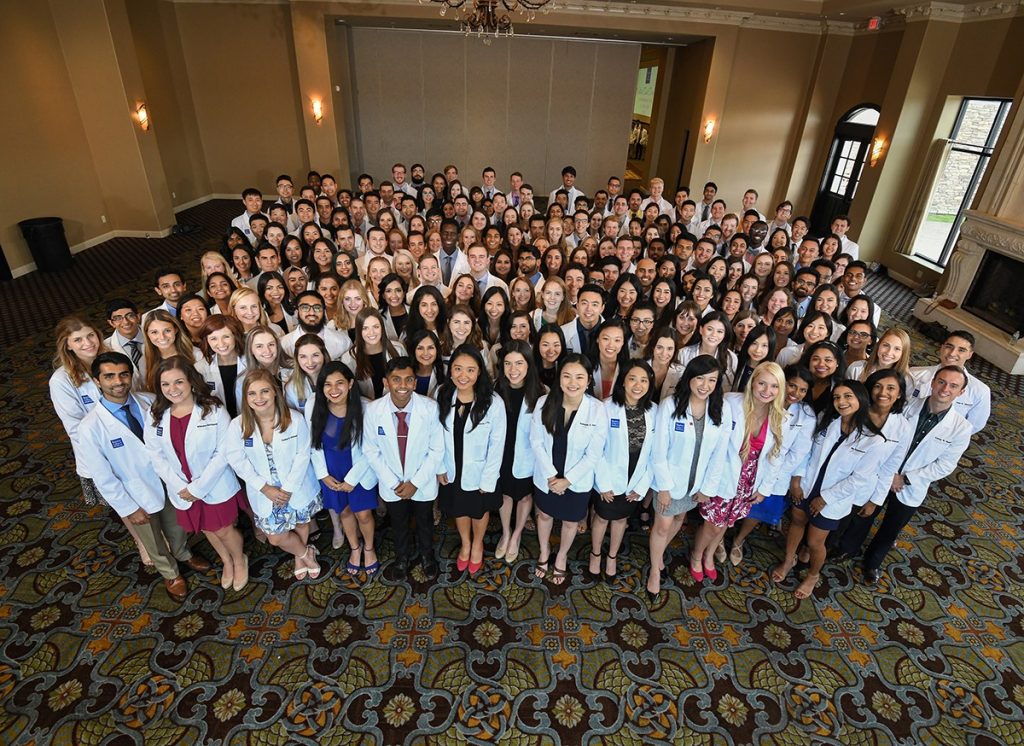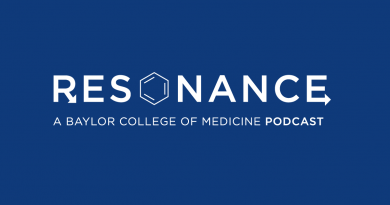Lessons from an old white coat
Editor’s note: On Aug. 9, 2019, the Class of 2023 participated in a much-anticipated annual ritual—the White Coat Ceremony. Below is the student keynote speech delivered by fourth-year medical student Sally Huang, on the honor and responsibility to take care of both self and others that the white coat brings.
When I first started medical school four years ago, I often got the advice: “Med school is a marathon. Pace yourself.” Though I never said it aloud, the automatic association in my mind when I heard those words was of a sign I often see at actual marathons: “That’s a lot of work for a banana!”
As tired and cliché as that advice might seem, in reflecting on the last four years I’ve come to see that the common wisdom is true. On this long, rewarding journey, I’ve learned and grown more and in more ways than I could ever have imagined four years ago, when I sat where you’re sitting at this very moment.
I don’t need to tell you what this coat represents – you’ve probably experienced it yourself, when you saw your own doctor, or accompanied family members or friends to the hospital or clinic. You’ve worked hard for the privilege to care for your fellow human beings, to respond to the call of those who are suffering and offer your presence, your compassion, your attention and skill, in hopes of making the world a better place. You’ve already written yourself into the stories of others, making a positive contribution to those stories an important part of writing your own.
I thought long and hard about what I have to offer to your class of already-accomplished physicians-in-training. As I stand here now, four years older and hopefully wiser, I’d like to offer three lessons from an old white coat: this very coat I’m wearing now.

The first lesson.
Soon – as early as next month – you’ll wear your coat to your first session with your preceptor, seeing patients as a medical student for the first time. You’ll continue to wear the coat to the hospital, to the clinic, and into clinical rotations. One day you might notice your coat has a stain and needs to be washed. Maybe you’ve worn it one too many times in the Houston heat, and it’s starting to smell of sweat. Maybe it catches on a sharp object and needs to be repaired.
When that happens, you’ll wash it, mend it, iron it, hang it on that special hanger in the closet. You will scan it carefully for signs of wear and tear, knowing what it represents: the privilege you have of caring for others, the measured access to people’s stories, the discipline and hard work that went into getting here. So, the first lesson is: take care of yourself as you care for your coat. If medicine is a marathon, then you will need to take care of and be kind to yourself along the way.
Beyond the obvious metaphors of maintaining personal hygiene, avoiding injury, and taking measures to prevent yourself from getting sick, remember to not just check in with yourself, but give yourself real time and space to reflect, to breathe. You will encounter, learn, and absorb so much in this next year – give yourself time to process these experiences, remembering that reflection can be a form of care in and of itself.
Take a break from studying: grab coffee – or boba – with friends, catch the latest movie, read a book, go for a long run or bike ride, call home. Though caring for others is often a way of caring for ourselves, in caring for others, we must first care for ourselves. Every time you wash your coat or check it for signs of wear and tear, remember to care for yourself, too.
The second lesson.
One fall afternoon a few years ago, I arrived home after a long day on my rotation. I took my coat off and was shocked to see a large green stain that my beloved pen had left, unbeknownst to me, earlier that afternoon. I wasn’t sure how it had gotten there – did I leave the pen uncapped, or did it just explode? – but scrub and bleach the area as I might, the green patch remained.
New coats carry a hefty price tag, and I, a broke med student, elected to keep mine as it was. After all, my ability to care was neither determined nor hampered by a few drops of ink on my coat.I’ve carried this mark for two years now, and it remains on my coat today. I did consider getting a new coat for this ceremony, then decided against it when I realized there was a lesson to be found here: it’s okay to fail. And when you fail, though the urge may be to immediately cover it up, sometimes trying to conceal a failure can be more painful and harmful than acknowledging it, learning what you can from it, and moving forward.
In a field like medicine, where entry is competitive and the stakes are high, it often feels like failure is not an option. We start to believe that the very vulnerability, sensitivity, and fragility that make us human are weaknesses, qualities that bring shame. But we must not lose sight of the delicate balance in which all things hang: the path to success is often lined with many failures.
This is easier said than done. When I was a second-year student, I failed a term exam. At the time, I told few people outside of the deans and my best friend. I hid the failure from everyone else, only to find when I showed up for the remediation exam that I was far from alone. I wish now that I’d spoken more openly then about what I was going through, wearing my failure not as a badge of pride, but as a marker of growth.
When the time came to prepare for my board exams, the unit that I had failed became the material I knew best, because I had spent extra time studying it. It was a failure that showed me my limits and pushed me to overcome them. I’m glad I can speak openly about it now, as I did not have the courage to do so then.
The final lesson.
I had a patient on my psychiatry rotation – we’ll call her Ms. O – who used to ask me anxiously, after our daily team check-ins with her, if she had done a good job answering our questions. Over time I saw that she trusted me, the medical student who had the most time to spend with her out of anyone else on the team, and viewed me as her confidant. When it was time for her to leave the hospital, she pulled me into a hug and thanked me with tears in her eyes.
What was so remarkable about my time with Ms. O? In all the time I cared for her – the 10 days of her inpatient stay – I never once wore my white coat. In fact, in many of my most significant patient encounters – the times when I felt I really connected with the patient, or that I really made a difference – I was not wearing my white coat. So, here’s the third lesson: it’s not about the coat, but about the person wearing the coat.
What makes you a medical student, a future doctor, a future caretaker for patients, is not the white coat. It’s the qualities you already possess – your compassion, your discipline, your altruism, your intelligence – the things that make you uniquely you, that brought you here. When you look around now and take stock of your classmates – some of whom will become your closest friends over the next four years – you may experience that insidious feeling: imposter syndrome, that fear that you shouldn’t be here. In those moments, remember who you are; remember that you belong. You belong at Baylor College of Medicine.
And tonight, in the presence of your family and friends – those who have supported and guided you along the way – you embark on what is truly the journey of a lifetime, with the donning of your white coat. We recognize and honor you, for who you are, for all you’ve already accomplished, and for the commitment you’ve made to serving humankind.
Here’s the “TLDR:” Take care of yourself – love yourself – as you would your coat, as you do your friends and family, as you will your patients. Don’t be afraid to fail or make mistakes and learn from them. Wear the white coat with honor, remembering all that it represents – humanism, compassion, service – and all that you already embody. The road is long, but you have the support of friends and family and the Baylor community – and from where I’m standing, I can tell you that the rewards will be far greater than a banana.


